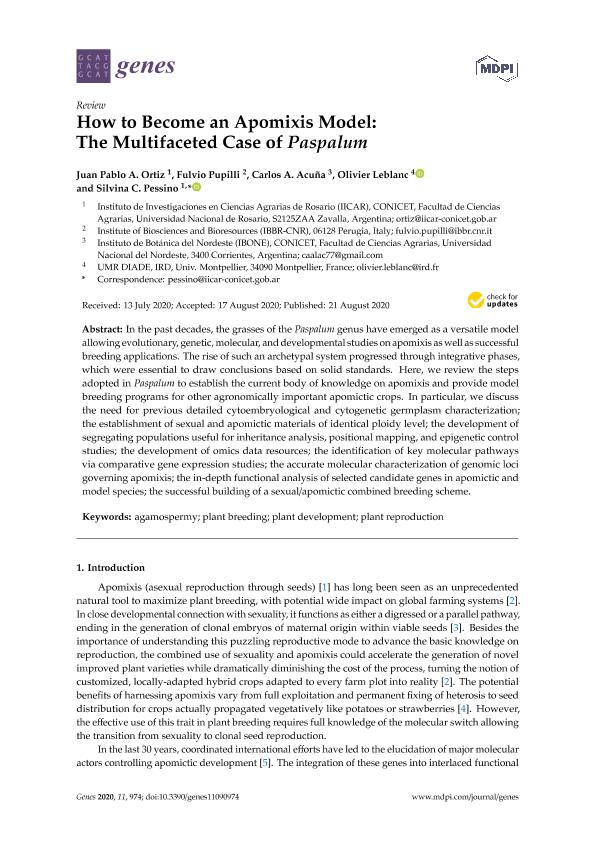Mostrar el registro sencillo del ítem
dc.contributor.author
Ortiz, Juan Pablo Amelio

dc.contributor.author
Pupilli, Fulvio
dc.contributor.author
Acuña, Carlos Alberto

dc.contributor.author
Leblanc, Olivier
dc.contributor.author
Pessino, Silvina Claudia

dc.date.available
2022-07-28T11:39:23Z
dc.date.issued
2020-09
dc.identifier.citation
Ortiz, Juan Pablo Amelio; Pupilli, Fulvio; Acuña, Carlos Alberto; Leblanc, Olivier; Pessino, Silvina Claudia; How to become an apomixis model: The multifaceted case of Paspalum; MDPI AG; Genes; 11; 9; 9-2020; 1-27
dc.identifier.issn
2073-4425
dc.identifier.uri
http://hdl.handle.net/11336/163349
dc.description.abstract
In the past decades, the grasses of the Paspalum genus have emerged as a versatile model allowing evolutionary, genetic, molecular, and developmental studies on apomixis as well as successful breeding applications. The rise of such an archetypal system progressed through integrative phases, which were essential to draw conclusions based on solid standards. Here, we review the steps adopted in Paspalum to establish the current body of knowledge on apomixis and provide model breeding programs for other agronomically important apomictic crops. In particular, we discuss the need for previous detailed cytoembryological and cytogenetic germplasm characterization; the establishment of sexual and apomictic materials of identical ploidy level; the development of segregating populations useful for inheritance analysis, positional mapping, and epigenetic control studies; the development of omics data resources; the identification of key molecular pathways via comparative gene expression studies; the accurate molecular characterization of genomic loci governing apomixis; the in-depth functional analysis of selected candidate genes in apomictic and model species; the successful building of a sexual/apomictic combined breeding scheme.
dc.format
application/pdf
dc.language.iso
eng
dc.publisher
MDPI AG
dc.rights
info:eu-repo/semantics/openAccess
dc.rights.uri
https://creativecommons.org/licenses/by/2.5/ar/
dc.subject
AGAMOSPERMY
dc.subject
PLANT BREEDING
dc.subject
PLANT DEVELOPMENT
dc.subject
PLANT REPRODUCTION
dc.subject.classification
Otras Biotecnología Agropecuaria

dc.subject.classification
Biotecnología Agropecuaria

dc.subject.classification
CIENCIAS AGRÍCOLAS

dc.title
How to become an apomixis model: The multifaceted case of Paspalum
dc.type
info:eu-repo/semantics/article
dc.type
info:ar-repo/semantics/artículo
dc.type
info:eu-repo/semantics/publishedVersion
dc.date.updated
2021-09-06T21:14:34Z
dc.journal.volume
11
dc.journal.number
9
dc.journal.pagination
1-27
dc.journal.pais
Reino Unido

dc.journal.ciudad
Londres
dc.description.fil
Fil: Ortiz, Juan Pablo Amelio. Consejo Nacional de Investigaciones Científicas y Técnicas. Centro Científico Tecnológico Conicet - Rosario. Instituto de Investigaciones en Ciencias Agrarias de Rosario. Universidad Nacional de Rosario. Facultad de Ciencias Agrarias. Instituto de Investigaciones en Ciencias Agrarias de Rosario; Argentina
dc.description.fil
Fil: Pupilli, Fulvio. Consiglio Nazionale delle Ricerche; Italia
dc.description.fil
Fil: Acuña, Carlos Alberto. Consejo Nacional de Investigaciones Científicas y Técnicas. Centro Científico Tecnológico Conicet - Nordeste. Instituto de Botánica del Nordeste. Universidad Nacional del Nordeste. Facultad de Ciencias Agrarias. Instituto de Botánica del Nordeste; Argentina
dc.description.fil
Fil: Leblanc, Olivier. No especifíca;
dc.description.fil
Fil: Pessino, Silvina Claudia. Consejo Nacional de Investigaciones Científicas y Técnicas. Centro Científico Tecnológico Conicet - Rosario. Instituto de Investigaciones en Ciencias Agrarias de Rosario. Universidad Nacional de Rosario. Facultad de Ciencias Agrarias. Instituto de Investigaciones en Ciencias Agrarias de Rosario; Argentina
dc.journal.title
Genes
dc.relation.alternativeid
info:eu-repo/semantics/altIdentifier/doi/http://dx.doi.org/10.3390/genes11090974
Archivos asociados
